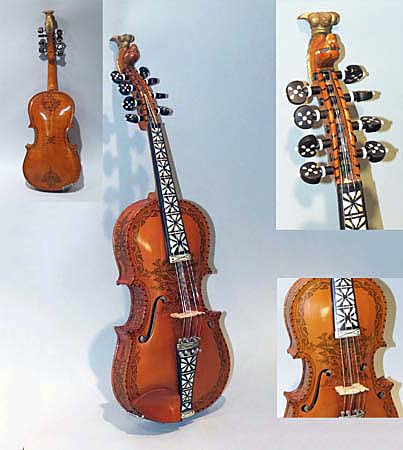
Owner: HWMC
Catalog#: 2CL-CHLT-015
Violin Family
'Hardanger/Hardingfele' Fiddle - Knudt G. Helland
Norway
European
Wood, pearl, bone, paint
Early 20th century
Length: 25 in, Width: 8.5 in (overall)
Strings – Lutes – Violin Family
Labeled: Knudt G. Helland violin maker – Signed: Knudt (1880-1920) (Chippewa Falls) Barron Co. Wis 1904. The Helland family from Bø in Telemark is a Norwegian dynasty of Hardanger fiddle makers who made the most significant and important contribution to the development of the Norwegian Hardanger fiddle tradition.
The Hardanger fiddles or Hardingfele is a traditional stringed instrument from Norway. This one has 4 melody strings and 4 sympathetic strings. The fretless wooden body has a dark stained fretboard. The fretboard has mother of pearl inlay with a sunburst design between each of the fret areas (7 sunbursts total). The 8 wooden tuning pegs are inlaid with mother of pearl as well, with 4 teardrop leaves emanating out from a small circle on each side of the tuning pegs’ grip. They are also tipped with small round bits of bone. The pegs are situated directly below the top of the neck which is carved to look like a dragon with teeth and a tongue wearing a gold-painted crown. The tailpiece has 3 and a half of the same sunburst designs as the fretboard and is situated over the body similar to the fretboard. There is an unlacquered wooden bridge situated between the tailpiece and the fretboard, but below the pen work of floral design in the center of the violin’s body. On either side of the bridge is an acoustic hole which runs almost perpendicular to the body of the instrument, making the top of the body slightly more rounded. There is a striped trim on the entire body, and the sides, front, and back all have intricately carved floral designs near the edges and center. These designs are symmetrical. There is also a lacquered wood chin rest attached with silver metal fastenings.
The tuning of the Hardanger fiddle/Hardingfele (Norway) is a whole step higher than the violin. So instead of an E on the violin, the top string is an F#.
